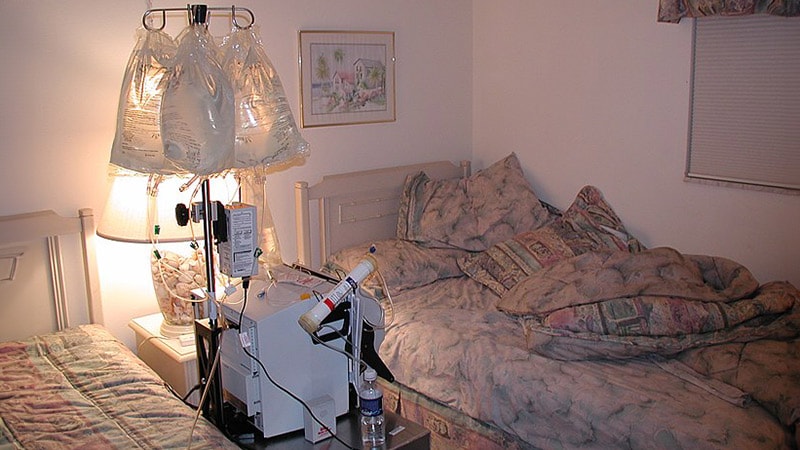Improved Cardiovascular Outcomes Observed in Home Hemodialysis Compared to Peritoneal Dialysis
Основные понятия
Home hemodialysis is associated with lower risks of cardiovascular events, cardiovascular death, and all-cause death compared to peritoneal dialysis among patients receiving home kidney dialysis.
Аннотация
This large observational study examined cardiovascular outcomes in over 68,000 patients who initiated home dialysis between 2005 and 2018. The key findings are:
- Patients on home hemodialysis had a 8% lower risk of all-cause death, 22% lower risk of cardiovascular death, and 8% lower risk of cardiovascular events compared to those on peritoneal dialysis.
- The risk of stroke was 42% lower and the risk of acute coronary syndrome was 17% lower with home hemodialysis versus peritoneal dialysis.
- No significant difference was found in the risk of heart failure between the two dialysis modalities.
- The authors suggest the improved cardiovascular outcomes with home hemodialysis may be due to better fluid management, solute clearance, and control of bone/mineral metabolism parameters.
- However, the study acknowledges several caveats, including potential differences in underlying risk factors and residual kidney function between the two patient groups that were not fully accounted for.
- Experts note that modifiable factors like smoking and poverty have a stronger association with cardiovascular risk in home dialysis patients, and strategies to address disparities in care are needed.
- The small difference in cardiovascular outcomes should not be the primary driver in home dialysis modality choices, which should be individualized based on patient goals and preferences.
Customize Summary
Rewrite with AI
Generate Citations
Translate Source
To Another Language
Generate MindMap
from source content
Visit Source
www.medscape.com
Cardiovascular Outcomes Better With Home Hemodialysis
Статистика
Patients on home hemodialysis had a 42% lower risk of stroke compared to peritoneal dialysis.
Patients on home hemodialysis had a 17% lower risk of acute coronary syndrome compared to peritoneal dialysis.
Patients on home hemodialysis had a 22% lower risk of cardiovascular death compared to peritoneal dialysis.
Patients on home hemodialysis had an 8% lower risk of all-cause death compared to peritoneal dialysis.
Цитаты
"We found that patients on incident home hemodialysis had a lower adjusted risk of cardiovascular events, cardiovascular death, and all-cause death."
"As many as half of the patients undergoing dialysis are reported to have cardiovascular disease, and those patients have a 20 times higher risk for cardiovascular death than the general population, with cardiovascular disease representing the leading cause of death among those patients."
"I think there may be better fluid management with home hemodialysis. So, with more intensive dialysis, there is better solute clearance in blood and better control of bone and mineral metabolism parameters."
Ключевые выводы из
by Nancy A. Mel... в www.medscape.com 07-26-2024
https://www.medscape.com/viewarticle/cardiovascular-outcomes-better-home-hemodialysis-2024a1000dsh
Дополнительные вопросы
What are the potential underlying differences in patient characteristics and risk factors between the home hemodialysis and peritoneal dialysis groups that were not fully accounted for in this study?
While the study adjusted for various confounders, there are several potential underlying differences in patient characteristics and risk factors between the home hemodialysis and peritoneal dialysis groups that may not have been fully considered. One key factor is the level of support and resources available to patients opting for home hemodialysis versus peritoneal dialysis. Patients choosing home hemodialysis may have better home support, better dexterity, or less frailty, which could impact their cardiovascular outcomes. Additionally, the study did not account for differences in residual kidney function, which is a significant predictor of mortality in dialysis patients. Other unmeasured factors could include socioeconomic status, access to healthcare services, comorbidities, and lifestyle factors, all of which can influence cardiovascular risk in dialysis patients.
How can disparities in access to home dialysis modalities and associated cardiovascular risk factors be addressed to improve outcomes for all dialysis patients?
To address disparities in access to home dialysis modalities and associated cardiovascular risk factors, several strategies can be implemented. Firstly, there is a need for increased education and awareness among patients, healthcare providers, and policymakers about the benefits of home dialysis options. This includes providing information on the potential cardiovascular outcomes associated with different modalities. Healthcare systems should prioritize expanding access to home dialysis programs, ensuring that patients have the necessary resources and support to choose the modality that best suits their needs. Addressing socioeconomic disparities, providing financial assistance, and improving training programs for home dialysis can also help reduce barriers to access. Additionally, implementing policies that promote patient-centered care and shared decision-making can empower patients to make informed choices about their dialysis treatment, ultimately improving outcomes for all dialysis patients.
Given the small differences in cardiovascular outcomes observed, what other factors should be prioritized when choosing between home hemodialysis and peritoneal dialysis for individual patients?
When choosing between home hemodialysis and peritoneal dialysis for individual patients, it is essential to consider a range of factors beyond cardiovascular outcomes. Patient preferences, lifestyle, convenience, and quality of life should be prioritized to ensure that the chosen modality aligns with the patient's goals and values. Factors such as treatment flexibility, ease of administration, impact on daily activities, and psychological well-being should also be taken into account. Additionally, the patient's ability to adhere to the treatment regimen, access to support networks, and potential complications associated with each modality should be carefully evaluated. Shared decision-making between patients, caregivers, and healthcare providers is crucial in determining the most suitable dialysis modality for each individual, taking into consideration the holistic needs and preferences of the patient.
0
